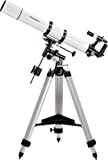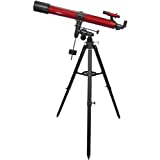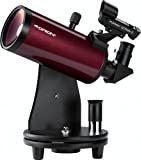90mm telescopes – Buying guide & Comparison
If you’re short on time and you just want to find the best 90mm telescope, this short paragraph should help you get exactly the model you need. According to our findings, the Orion 9024 AstroView is the best because it is both affordable and entirely capable of doing its job at a more than satisfactory level. Its 90mm aperture and 910mm focal length will enable you to get a clear picture of planets, deep-sky objects, as well as the moon. The main unit is accompanied by an impressive number of extras as you’ll notice that the box contains the 1.25” eyepieces, as well as a 90-degree mirror diagonal, unique software, and much more. If the Orion 9024 AstroView is unavailable, your second option should be the Carson Red Planet RP-400.
Comparison table
 Our Top Choice
Our Top Choice
The large objective lens of 90mm is one of the greatest features of this model, as it allows the unit to gather enough light from the surrounding environment so that you can get a bright and detailed image when you examine the planets and other celestial objects on the night sky. The model comes with unique software included so that you can easily identify the celestial bodies you are looking at. It has a classic refractor design.
The tripod leaves something to be desired, and you might want to purchase one separately.
An affordable telescope with more than decent performance and extras.
 2nd Best
2nd Best
The optical performance is excellent, and it is the number one reason why this particular model gets such satisfied reviews from users. The lens is fully multi-coated, which means that the image you will be able to examine through the telescope will be bright, crisp, and free of chromatic aberrations. The heavy-duty aluminum tripod is a great plus, and it offers the stability you need for your telescope.
The unit is bulky, so don’t expect it to be a good deal for school projects, as kids won’t be able to move it.
An excellent option for people who are seeking performance at a decent price.
Also To Consider
Not all telescopes must be portable, and if you are looking for an affordable model that will offer you the possibility to look at the night sky and see the celestial bodies from up close, this tabletop model is right up your alley. The unit is lightweight, at only 6.5 pounds, and it offers a good performance. You can take it outside, if you wish, as long as you make sure that the unit is not affected by other sources of light.
The instructions on how to use it can be a tad challenging, so there is a steep learning curve involved.
A tabletop option for those who want a telescope for their home.
There are many factors to give some thought to if you’re in the market for a 90mm telescope, and that’s why we’re here to help you make the best decision. Aside from the size of the aperture, you also have to take into account many other details, and we’ll make sure to tackle them all in our comprehensive buyer’s guide. Check it out below.
What will you be able to see?
If you’ve ended up here, you’re probably looking for the best 90mm refractor telescope or a catadioptric or reflector alternative that raises up to par. But, if you’re a beginner, what you first have to consider is the celestial objects you can take a look at with the help of such a device.
Most telescopes that measure between 60 and 80mm in aperture will offer you decent images of Saturn, Jupiter, the moon, as well as several bright star clusters and cloudy nebulas. Anything above 90mm will let you take a peek at the same celestial objects, but the neat thing will be that you will be able to see a greater amount of detail, as well as dim objects such as galaxies.
With every aperture increase, you’ll be able to see greater detail and notice a difference in terms of performance. Unfortunately, telescopes that have apertures of 150mm are not as budget-friendly as the formerly mentioned alternatives.
Portability matters
Unless you plan to use your telescope in a closed space for the rest of its existence, you’re probably interested in taking it on the road and doing a bit of stargazing outdoors. In that case, you need to analyze purchasing factors such as the weight of the product and its overall size.
If it comes with its own carrying case, even better, as you’ll be able to transport all the components without worrying about getting them damaged. While paying attention to the dimensions and the weight of the product is useful, without a doubt, you might have to take the time to go through the best 90mm telescope reviews as other users just like you can let you know just how easy or hard it is for them to put the telescope together and then take it apart again.
What type of telescope do you plan to get?
Another factor that should be on your mind is the exact kind of telescope you might be looking for. There are three types to choose from, and each and every one offers both advantages and disadvantages.
Refractor units are somewhat common compared to their counterparts. They are usually thought of as good-quality alternatives that have a rugged build and that boast a construction that enables them to be portable. Unfortunately, due to their rather long tube, you’ll have to use a sturdier and larger tripod.
Reflectors have smaller tubes when compared to those of their refractor counterparts. They’re also good choices if you’re focused on portability, and perhaps even more so compared to refractors. The only drawback about them is that they require a bit of time spent on cleaning and maintenance as they tend to accumulate dust around their lenses.
Catadioptric units are combinations in that they offer the pros of both refractors and reflectors. Because they are remarkably powerful and compact, these options tend to cost a pretty penny so they might be less recommended for beginners whose budgets are quite limited.
5 Best 90mm Telescopes (Reviews) in 2024
Now you’re aware of the most important details that you have to bear in mind when prospecting the market for such a telescope. Perhaps you’d enjoy the following selection as it is based on the top-rated choices that we were able to discover while sifting through the many options available for sale these days.
Contents
- 1. Orion 9024 AstroView 90mm Equatorial Refractor Telescope
- 2. Carson Red Planet 50-100x90mm Refractor Telescope For Astronomy
- 3. Orion 10022 StarMax 90mm TableTop Maksutov Cassegrain Telescope
- 4. Meade Instruments Infinity 90AZ Refractor Telescope Metallic Blue
- 5. Orion 10029 StarBlast 90mm Altazimuth Travel Refractor Telescope
1. Orion 9024 AstroView 90mm Equatorial Refractor Telescope

The 90mm aperture and 910mm focal length that this unit comes with will allow you to have a peek at deep-sky objects, the Moon, Jupiter, Saturn, as well as planets, in general. The classic refractor design seems to be a clear advantage, as is the fact that the Starry Night software is part of the deal with this model.
Based on the information that we have come across, it appears that the mounting system that accompanies this product could be less stable than you’d like it, which is why it might be a good idea to purchase a separate tripod.
Pros
This powerful, high-quality refractor telescope comes with a large-enough aperture of 90mm to gather sufficient light from celestial objects and provide clear, crisp images for astronomical viewing and casual study.
The two included 1.25-inch Sirius Plossl eyepieces allow you to select the level of magnification you need to perform your astronomical observations based on the weather conditions or your purpose.
The supplied EQ-2 adjustable tripod works well with the equatorial mount to enable the manual, slow-motion tracking of celestial objects as they move through the sky so you can follow their movement easily.
The 6×30 finderscope enables you to easily aim the scope on your object of choice, thus eliminating the need to search on your own for the objects to observe.
The 1.25-inch rack-and-pinion focuser enables smooth adjustments to the perfect observation height and setting for optimal viewing results every time.
Cons
Although designed to be a beginner instrument, this model may take kids some time to master the use of as there are complicated parts that need to be used optimally.
Buy from Amazon.com
2. Carson Red Planet 50-100x90mm Refractor Telescope For Astronomy

In fact, the equatorial mount that the tripod has been outfitted with counteracts movements, as well as shakings which might inevitably affect your user satisfaction. As with other telescopes that come with the same aperture, this one can be utilized with great results if you plan to look at the moon, Jupiter, Saturn, and other sky bodies and structures.
Owners seem to think that this unit is well worth the money and that it is built to be sturdy and resilient so that it withstands the test of time.
Pros
Suitable for those already familiar with the workings of a basic telescope, this instrument features an equatorial-style mount that enables the smooth, slow-motion tracking of sky objects moving across the sky for more involved viewing.
The supplied 6×30 finderscope enables the easy locating of target objects to reduce the time it takes to find them so you can get on with the observation immediately.
This telescope ships with a number of viewing accessories including a Plossl 20mm eyepiece, a Plossl 10mm eyepiece, a 90-degree corner lens, plus an adjustable aluminum tripod, all enhancing the functionality of the device.
The fully-coated optics provide superior viewing for an amazing ability to collect light from the sky objects for clear and sharp images every time.
The heavy-duty aluminum tripod provides an efficient way of holding the scope steady while viewing to prevent getting shaky images.
Cons
This is a huge and heavy telescope that small kids may not be able to lift and operate by themselves without the help of an adult.
Buy from Amazon.com
3. Orion 10022 StarMax 90mm TableTop Maksutov Cassegrain Telescope

This tabletop alternative has been designed to offer excellent performance which will enable you to look at bright deep space objects such as nebulas, clusters, as well as galaxies. As if that weren’t enough, you’ll be able to focus the image so that you get a clear picture of Mars, Jupiter, as well as Saturn.
Furthermore, it is worth emphasizing that the weight of this telescope is just 6.5 lbs after being assembled, which means that with the proper equipment, you can take it outside, in your backyard or in any other open space where it can’t be affected by street light.
Pros
A grab-and-go Maksutov-Cassegrain telescope, this tabletop instrument helps the beginner astronomer get fantastic views of the Moon and be astounded by the brilliance of the planets and their distinguishing marks such as the rings of Saturn, the hugeness of Jupiter, and the amazingly red surface of Mars.
When assembled, the whole instrument only weighs 6.5 pounds, making it a compact and lightweight device that can be brought anywhere easily so you can do night sky viewing during road trips or outdoor activities such as hiking and camping, or just a family night out in the backyard.
This telescope collects enough light to deliver brilliant and clear images that you can enjoy studying and observing.
The cool tabletop base serves as a stable viewing structure that can be positioned on the tabletop or attached to a strong field tripod for easy viewing.
Cons
This telescope takes a bit of a learning curve to optimize its functionality so it is best to study all the features prior to more detailed viewing attempts.
Buy from Amazon.com
4. Meade Instruments Infinity 90AZ Refractor Telescope Metallic Blue

This particular option comes with everything that you might need in that it even includes an Altazimuth mount with a panhandle, which means that you will be able to control the device so that you can focus and track the objects in a perfect manner.
Besides, the unit is accompanied by high, medium, and low magnification eyepieces as well as two Barlow lenses. What’s more, both the software and the instructional DVD can be found to be part of the deal with this product.
Pros
With its aperture of 3.5 inches, this model collects enough light from celestial objects in order for the user to view clearer and sharper images compared to using the naked eye alone.
The rack-and-pinion focuser works well with the revolutionary altazimuth mount with panhandle in order to bring celestial objects into clear focus and also follow celestial targets as they move across the night sky in manual slow motion.
The supplied low, medium, and high magnification eyepieces provide the exact viewing capacity for the scope so you can view details and distinguishing characteristics of various deep-sky objects.
The state-of-the-art red dot viewfinder enables the user to aim the device at the exact objects to be observed.
The convenient accessory tray provides storage for the essential accessories to keep them within easy reach during observations.
Cons
This telescope does not enable the viewing of objects in the right-side-up orientation, which can be achieved if an erect image diagonal is purchased separately.
Buy from Amazon.com
5. Orion 10029 StarBlast 90mm Altazimuth Travel Refractor Telescope

The Altazimuth mount that the unit has been outfitted with can make sure that you take advantage of slow-motion controls so that you keep tabs on the objects that might be of specific interest to you. Based on what we found about it, the Altazimuth belonging to the Orion StarBlast is remarkably easy to utilize.
Since no product assessment is complete without an eye thrown on the ratings that the unit has gathered, it’s worth noting that the StarBlast has acquired mostly favorable reviews. Depicted as the best investment and a great overall performer, this telescope can inevitably serve you when you need it the most.
Pros
This refractor telescope makes a terrific grab-and-go device that both beginners and experienced hobbyists will find highly useful for sky viewing.
The perfect travel scope for campouts and family outdoor adventures, this model features an easy-to-operate design.
The altazimuth mount provides easy operations and is geared with slow-motion controls to enable the easy tracking of objects moving across the night sky for motion studies.
The supplied eyepieces provide just the right magnification levels while the EZ Finder II aiming sight facilitates the easy locating of target objects, including Jupiter and its bright moons, Saturn and its lovely rings, and the Moon, planets, and comets.
The 90-degree star diagonal enables the easy viewing of objects comfortably in an upright position so you can view details more easily and with fewer issues on details.
Cons
The supplied instructions in the package received by one customer are not for this model. Thankfully, the device offers intuitive setup and use so it can still be optimized in functionality.
Buy from Amazon.com












